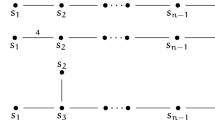Abstract
The descent algebra of a finite Coxeter group W is a subalgebra of the group algebra defined by Solomon. Descent algebras of symmetric groups have properties that are not shared by other Coxeter groups. For instance, the natural map from the descent algebra of a symmetric group to its character ring is a surjection with kernel equal the Jacobson radical. Thus, the descent algebra implicitly encodes information about the representations of the symmetric group, and a complete set of primitive idempotents in the character ring leads to a decomposition of the group algebra into a sum of right ideals indexed by partitions. Stanley asked whether this decomposition of the regular representation of a symmetric group could be realized as a sum of representations induced from linear characters of centralizers. This question was answered positively by Bergeron, Bergeron, and Garsia, using a connection with the free Lie algebra on n letters, and independently by Douglass, Pfeiffer, and Röhrle, who connected the decomposition with the configuration space of n-tuples of distinct complex numbers. The Mantaci–Reutenauer algebra of a hyperoctahedral group is a subalgebra of the group algebra that contains the descent algebra. Bonnafé and Hohlweg showed that the natural map from the Mantaci–Reutenauer algebra to the character ring is a surjection with kernel equal the Jacobson radical. In 2008, Bonnafé asked whether the analog to Stanley’s question about the decomposition of the group algebra into a sum of induced linear characters holds. In this paper, we give a positive answer to Bonnafé’s question by explicitly constructing the required linear characters.
Similar content being viewed by others
References
Bergeron, F., Bergeron, N., Garsia, A. M.: Idempotents for the free Lie algebra and \(q\)-enumeration. In Invariant theory and tableaux (Minneapolis, MN, 1988), volume 19 of IMA Vol. Math. Appl., pages 166–190. Springer, New York, (1990)
Bishop, M., Douglass, J.M., Pfeiffer, G., Röhrle, G.: Computations for Coxeter arrangements and Solomon’s descent algebra III: Groups of rank seven and eight. J. Algebra 423, 1213–1232 (2015)
Bonnafé, C.: Representation theory of Mantaci-Reutenauer algebras. Algebr. Represent. Theory 11(4), 307–346 (2008)
Bonnafé, C., Hohlweg, C.: Generalized descent algebra and construction of irreducible characters of hyperoctahedral groups. Ann. Inst. Fourier (Grenoble) 56(1), 131–181 (2006). With an appendix by Pierre Baumann and Hohlweg
Church, T., Farb, B.: Representation theory and homological stability. Adv. Math. 245, 250–314 (2013)
Curtis, C.W., Reiner, I.: Methods of representation theory. Vol. I. John Wiley & Sons Inc., New York, With applications to finite groups and orders. A Wiley-Interscience Publication, Pure and Applied Mathematics (1981)
Douglass, J.M., Pfeiffer, G., Röhrle, G.: Cohomology of Coxeter arrangements and Solomon’s descent algebra. Trans. Amer. Math. Soc. 366(10), 5379–5407 (2014)
Garsia, A.M.: Combinatorics of the free Lie algebra and the symmetric group. In Analysis. et cetera, pp. 309–382. Academic Press, Boston, MA (1990)
Garsia, A.M., Reutenauer, C.: A decomposition of Solomon’s descent algebra. Adv. Math. 77(2), 189–262 (1989)
Hanlon, P.: The action of \(S_n\) on the components of the Hodge decomposition of Hochschild homology. Michigan Math. J. 37(1), 105–124 (1990)
Konvalinka, M., Pfeiffer, G., Röver, C.: A note on element centralizers in finite Coxeter groups. J. Group Theory 14, 727–745 (2011)
Mantaci, R., Reutenauer, C.: A generalization of Solomon’s algebra for hyperoctahedral groups and other wreath products. Comm. Algebra 23(1), 27–56 (1995)
Reutenauer, C.: Free Lie algebras, volume 7 of London Mathematical Society Monographs, New Series. The Clarendon Press, Oxford University Press, New York (1993)
Solomon, L.: A Mackey formula in the group ring of a Coxeter group. J. Algebra 41(2), 255–264 (1976)
Vazirani, M.: (1993) https://www.math.ucdavis.edu/~vazirani/CV/papers2011.html
Acknowledgements
The authors thank Nantel Bergeron, Götz Pfeiffer, and Monica Vazirani for helpful discussions.
Author information
Authors and Affiliations
Corresponding author
Additional information
This work was partially supported by a grant from the Simons Foundation (Grant #245399 to J. M. Douglass). The research of J. M. Douglass was supported by the NSF IR/D program, while working at the National Science Foundation. However, any opinion, finding, and conclusions or recommendations expressed in this material are those of the author and do not necessarily reflect the views of the National Science Foundation.
Rights and permissions
About this article
Cite this article
Douglass, J.M., Tomlin, D.E. A decomposition of the group algebraof a hyperoctahedral group. Math. Z. 290, 735–758 (2018). https://doi.org/10.1007/s00209-018-2039-8
Received:
Accepted:
Published:
Issue Date:
DOI: https://doi.org/10.1007/s00209-018-2039-8



